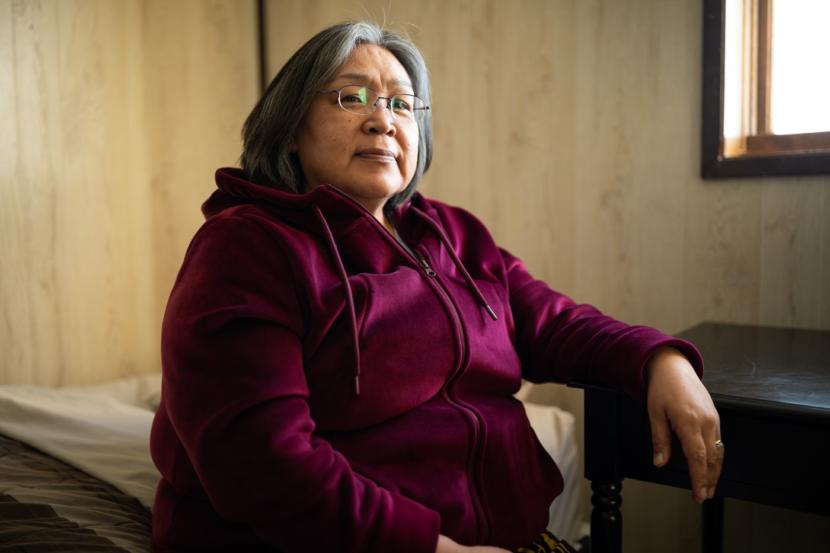
KIANA, Alaska — Village Police Officer Annie Reed heard her VHF radio crackle to life in the spring of 2018 with the familiar voice of an elder. I need help at my house, the woman said.
Reed, who doesn’t wear a uniform because everyone in this Arctic Circle village of 421 can spot her ambling gait and bell of salt-and-pepper hair at a distance, steered her four-wheeler across town. There had been a home invasion, she learned. One of the local sex offenders, who outnumber Reed 7-to-1, had pried open a window and crawled inside, she said. The man then tore the clothes from the elder’s daughter, who had been sleeping, gripped her throat and raped her, according to the charges filed against him in state court.
Reed, a 49-year-old grandmother, was the only cop in the village. She carried no gun and, after five years on the job, had received a total of three weeks of law enforcement training. She had no backup. Even when the fitful weather allows, the Alaska State Troopers, the statewide police force that travels to villages to make felony arrests, are a half-hour flight away.
It’s moments like these when Reed thinks about quitting. If she does, Kiana could become the latest Alaska village asked to survive with no local police protection of any kind.
An investigation by the Anchorage Daily News and ProPublica has found one in three communities in Alaska has no local law enforcement. No state troopers to stop an active shooter, no village police officers to break up family fights, not even untrained city or tribal cops to patrol the streets. Almost all of the communities are primarily Alaska Native.
Seventy of these unprotected villages are large enough to have both a school and a post office. Many are in regions with some of the highest rates of poverty, sexual assault and suicide in the United States. Most can be reached only by plane, boat, all-terrain vehicle or snowmobile. That means, unlike most anywhere else in the United States, emergency help is hours or even days away.
When a village police officer helps in a sex crime investigation by documenting evidence, securing the crime scene and conducting interviews, the case is more likely to be prosecuted, the University of Alaska Anchorage Justice Center concluded in 2018. Yet communities with no first responders of any kind can be found along the salmon-filled rivers of Western Alaska, the pancake tundra of the northwest Arctic and the icy rainforests in the southeast panhandle.
The state recognizes that most villages can’t afford their own police force and has a special class of law enforcement, called village public safety officers, to help. But it’s not working. In the 60 years since Alaska became a state, some Alaska Native leaders say, a string of governors and Legislatures have failed to protect indigenous communities by creating an unconstitutional, two-tiered criminal justice system that leaves villagers unprotected compared with their mostly white counterparts in the cities and suburbs.
ProPublica and the Daily News asked more than 560 traditional councils, tribal corporations and city governments representing 233 communities if they employ peace officers of any sort. It is the most comprehensive investigation of its kind in Alaska.
Here is what we learned:
- Tribal and city leaders in several villages said they lack jail space and police stations. At least five villages reported housing shortages that prevent them from providing potential police hires with a place to live, a practical necessity in some regions for obtaining state-funded VPSOs. In other villages, burnout and low pay, with some village police earning as little as $10 an hour, lead to constant turnover among law enforcement.
- In villages that do have police, more than 20 have hired officers with criminal records that violate state standards for village police officers over the past two years. They say that’s better than no police at all. Our review identified at least two registered sex offenders working this year as Alaska policemen.
- Alaska communities that have no cops and cannot be reached by road have nearly four times as many sex offenders, per capita, than the national average.
The lack of local police and public safety infrastructure routinely leaves residents to fend for themselves. The mayor of the Yukon River village of Russian Mission said that within the past couple years, residents duct-taped a man who had been firing a gun within the village and waited for troopers to arrive. In nearby Marshall, villagers locked their doors last year until a man who was threatening to shoot people had fallen asleep, then grabbed him and tied him up. In Kivalina, a February burglary closed the post office for a week because the village had no police officer to investigate. Elsewhere, tribes mete out banishment for serious crimes from meth dealing to arson.
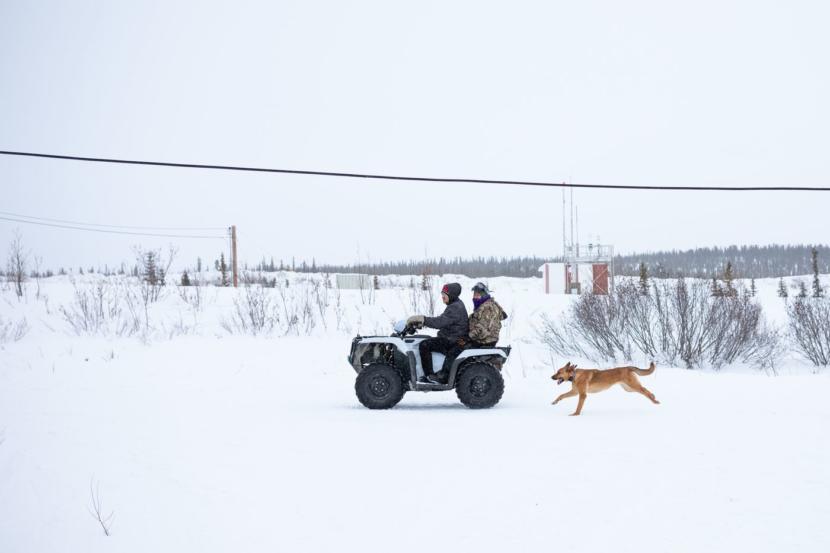
“There’s no one you can call and go, ‘Oh hey, my neighbor is going crazy right now,’” said Kristen George, tribal administrator for the Bristol Bay town of Clark’s Point, which balloons from 55 people to several hundred during the commercial fishing season.
If someone started shooting, George said, “they could probably wipe us out before troopers came.”
Many of the unprotected villages are in western Alaska, where sex crime rates are double the statewide average. (Alaska’s statewide rate, in turn, is nearly three times the U.S. average.) Rape survivors, as in the Kiana home invasion case, are told not to shower and must fly to hub cities or even hundreds of miles to Anchorage to undergo a sexual assault examination.
The problem is getting worse. Our investigation found the number of police provided through the state Village Public Safety Officer Program is at or near an all-time low; the few who remain are often unhappy and overextended.
When the lone VPSO in the northwest Arctic village of Ambler investigated a domestic violence call in April, for example, he said he was attacked by two people in the home who each grabbed one of his arms. In a subsequent report, he described it as one of the scariest moments of his life as he struggled to break free and grab a can of pepper spray.
“I was unable to get any assistance as I am the only law enforcement officer in this village within about a 100 square mile radius,” he wrote.
Rather than raise pay or boost recruitment, Gov. Mike Dunleavy this year proposed a state budget that would cut $3 million in funding for vacant village-based police officer jobs. The reductions are a small part of a proposed $1.8 billion reduction in state spending as cash-strapped Alaska struggles to live within its means while avoiding an income tax and continuing to pay annual Permanent Fund dividend checks to all eligible residents.
Dunleavy, a Republican, campaigned on promoting public safety, but he also promised Alaskans that they wouldn’t have to give up the annual oil wealth checks, and that those checks might increase. Under his proposed budget, each Alaskan would receive a more than $4,000 payment in October, the largest ever. (State lawmakers are working on a competing spending plan with fewer cuts, which would maintain VPSO funding at current levels and provide potentially smaller dividends.) Dunleavy has said growth in state spending is the problem, not annual checks to residents.
Whether each Alaskan also receives basic public safety protection — the ability to dial 911 and have a police officer or trooper show up at the door — depends largely on whether they live in cities like Anchorage and Fairbanks, or off the road system.
Martha Whitman-Kassock, who oversees self-governance programs for the Bethel-based Association of Village Council Presidents, grew up in rural Alaska and said the state appears to have no strategy for adding cops in villages.
“Public safety infrastructure and service in our region is a crisis,” she said.
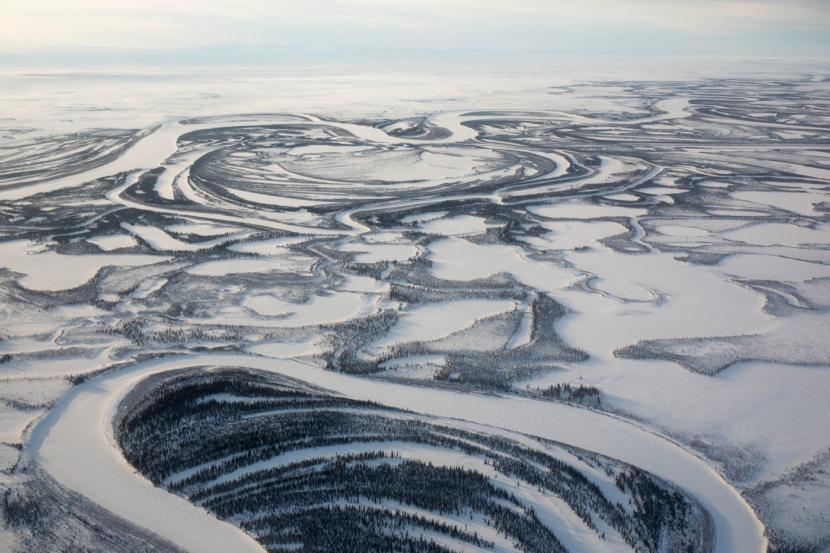
A Fight Over Public Safety Funding
Alaska is the size of Texas plus California plus both Carolinas, Florida and Maine. Purchased from Russia in 1867, the frontier attracted a flood of gold miners and church missionaries. The newcomers brought Western diseases — diphtheria and influenza, smallpox and tuberculosis — killing thousands of Alaska Natives. The missionaries built churches and, soon, boarding schools. So many village children were sexually abused by priests that a class-action lawsuit bankrupted the Fairbanks Diocese.
Lost in the talk of how best to spend Alaska’s dwindling revenue is an unanswered question: Did the state ever meet its public safety obligations to villagers?
Alaska’s state government settled a 1997 lawsuit demanding equitable funding for village schools after a judge called the state spending system “arbitrary, inadequate and racially discriminatory.” Alaska Native rights advocates contend that funding of public safety remains unfair.
In 1999, the Native American Rights Fund sued the state on behalf of 10 Alaska Native villages, including Kiana and Clark’s Point, calling the absence of police in remote communities racist and unconstitutional. The villages claimed that the state had violated Alaska Natives’ equal protection under the 14th Amendment of the U.S. Constitution by both opposing tribal courts’ authority to oversee criminal justice through traditional means while at the same time failing to provide armed police.
The Alaska Supreme Court upheld rulings against the villages in 2005, saying the lack of certified village cops could be explained by “financial and geographical constraints” rather than racial bias or purposeful neglect.
Early Alaska legislatures and state police saw the crisis coming.
In 1979, the state created the Village Public Safety Officer Program to place lifesaving peacekeepers in remote communities. The commander of the Alaska State Troopers at the time, Col. Tom Anderson, said the program was intended to “address some of the most serious, life-threatening problems of rural villages,” where accidental death rates are highest, by training officers to be firefighters and emergency medics as well as cops.
The number of these VPSOs, unarmed peace officers paid for with state funds but employed by regional nonprofits and boroughs, has plummeted from more than 100 in 2012 to 42 today. In some cases, promising VPSO recruits accept higher-paying offers in urban police departments or private security, leaving villages without their local officer.
Troopers’ ranks, too, have dwindled. Citing “critically low staffing levels,” the Alaska Department of Public Safety closed eight trooper posts between 2015 and 2018. Five years ago, the state employed 333 troopers statewide. At the end of last year, that number had shrunk to 293.
Law Enforcement on the Cheap
Outside Kiana City Hall, ravens pinwheeled above the trees on a weekday afternoon in March. A breeze carried snowmobile exhaust and wood smoke above newly built homes on stilts in the upper village down to old-town log cabins.
Inside the city building, council members in Carhartts and snow pants held their monthly meeting. For 90 minutes they shared powdered doughnuts and talked about utility rates, until it was time for Annie Reed to give a public safety report.
There had been several assaults over the past two weeks, said Reed, the village police officer who investigated the home invasion rape. “I was sick, so I didn’t do so much rounds. About 300 calls.”
When a village has no VPSO and no trooper, the only remaining option is an officer like Reed, hired by the local city government or tribe. Called village police officers or tribal police officers, they receive no benefits and are the lowest-paid and least-trained form of law enforcement in Alaska.
Reed makes about $20 an hour in a village where groceries cost twice Anchorage prices. These kinds of officers often find themselves performing tasks intended for armed, fully trained police. Reed thought she was going to be enforcing city ordinances like curfew and stopping underage drivers, not refereeing armed fights.
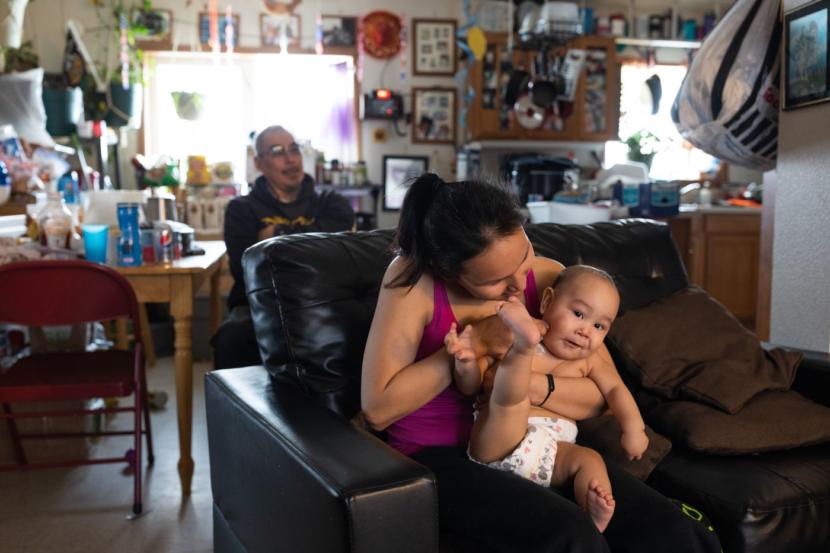
When people in Kiana need help they don’t dial 911, which would ring through to the Kotzebue Police Department nearly 60 miles away. They call Reed’s cellphone directly. The problems range from barking dogs to suicides to domestic brawls. She is never off duty.
“I have to drop my cooking and go. Or if my [grandkids] are getting ready to go to bed, I’m not there to say good night to them,” Reed said.
Suicides are worst. Calls involving domestic violence are common.
In Kiana, a series of trails and unpaved roads connect the neighborhoods, spilling onto the frozen rivers below. On one corner, a man with a mop of wild hair sat in his living room talking about the time he called Reed for help when his adult son began kicking him in the ribs. The man’s wife, left eye bruised, sat crying, saying she wished the local liquor store would close for the sake of Kiana’s children. The parents snapped at each other. As they argued, their daughter became angry. Why was everyone sharing family business, she asked?
The father leaped to his feet and pushed her across the living room. The young woman silently caught herself and slumped on the couch, her eyes returning to the TV.
“I don’t do meth,” her father said, although no one had asked.
A current VPSO, who asked not to be named and is not based in Kiana, said opening the door on one of these family fights is the most frightening task facing any solo Alaska peace officer.
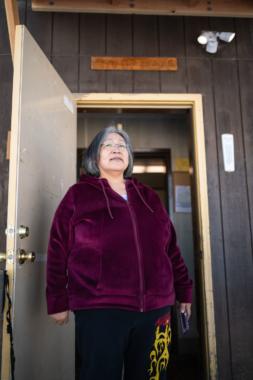
“The No. 1 most dangerous call you could ever go to is a domestic violence call. Hands down,” the VPSO said. “So we are doing the most dangerous call that there is on a consistent basis, by ourselves with no backup [and] no communication with dispatch other than a cellphone and no way to defend yourself.”
While state law allows for communities to arm VPSOs and even city-hired village police officers like Reed, the director of the Alaska Police Standards Council said he is not aware of any employers that do so, partly because it could make insurance liability rates skyrocket for small communities.
In Savoonga, a Bering Sea island community closer to Russia than to mainland Alaska, the police chief, Michael Wongittilin, said that the first time he put on his uniform, a man aimed a shotgun at him. “About 92% of this community have high-powered rifles,” he said. “We don’t even have [bulletproof] vests. We don’t even have Tasers.”
Reed said she’s never been shot at and tries to talk her way out of any scary encounters. She began working as a cop about five years ago when a family member said the job would suit her. “She said I was a strong and outgoing person.”
Reed’s home is a warm cocoon in the upper village, where an ebony finger of baleen, the broom-length filtration system from the mouth of a bowhead whale, hangs on the wall above a tornado of small children and small dogs. The whale hunt souvenir is one of the only signs that Kiana, an upriver village, is Reed’s adopted hometown. She is originally from Utqiagvik, the northernmost city in the United States, where whaling is a seasonal rite.
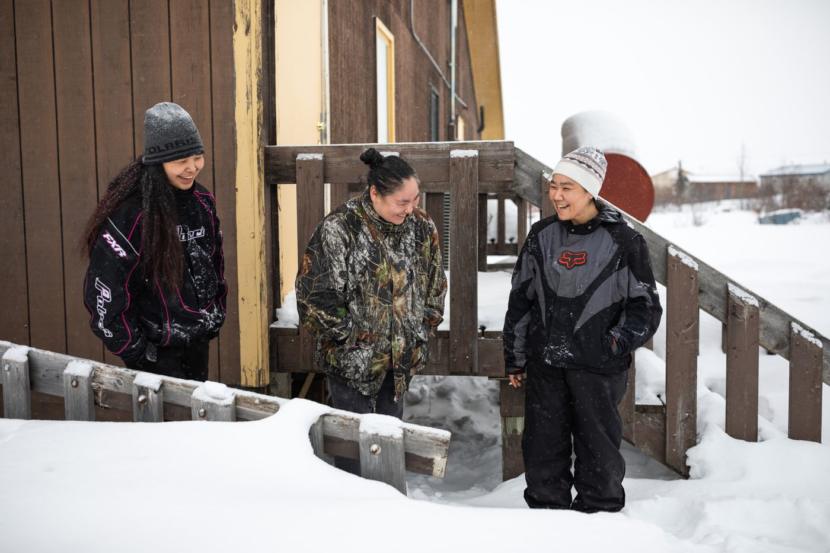
Family ties between police, crime victims and offenders are impossible to avoid in villages of a few hundred people. Many officers said those inherent conflicts make the job less appealing to potential applicants.
A quick walk from Reed’s house, Franswa Henry, 40, stepped into the blowing snow with his hands in his pockets. His breath steamed in the cold, his teeth clenched. Two bounding white puppies circled his feet.
Henry said he’s on probation and recently got out of jail in Nome, where someone broke his jaw. He was there serving time on an assault charge that Reed had investigated.
“I had a shotgun pulled on me. You know, I grabbed an ax,” Henry said. It was a messy family dispute between stepbrothers in January, with kids inside the home. Hours before a state trooper was able to get to the village, Reed arrived and took statements. Kotzebue prosecutors filed charges and Henry turned himself in a few days later, pleading guilty to fourth-degree assault. But he said Reed can’t possibly be impartial — the kids in the house were her grandchildren.
She said arresting neighbors is never easy.
“I still have a few friends out there and a few families that still talk to me,” she said. “It’s pretty hard when you have to arrest somebody and they’ll start hating you for a while.”
Henry noted that Reed, like many village police officers, has a rap sheet of her own. She pleaded guilty to a harassment charge in 2016 and to misdemeanor assault in 2012. Both cases involved fights with family members, a record that would prevent her from working as a police officer in Anchorage or other large departments. (Reed described the cases as minor events that do not interfere with her work. She otherwise declined to comment on them. “It’s the past,” she said.)
Under state law, village police officers are not supposed to have felony records but misdemeanors can be considered on a case-by-case basis. Alaska Police Standards Council Executive Director Bob Griffiths said domestic violence convictions of any kind usually disqualify someone from receiving state approval to be a village officer.
But village police officers with criminal records are routinely hired without a background check because village leaders do not inform the state of new hires, and the regulation requiring them to do so has no teeth, Griffiths said.
“There’s Not Anybody There Looking”
Not everyone wants more big-city style, badge-and-gun policing in Alaska villages. Often, city and tribal leaders seek a mix of traditional peacekeeping and modern law enforcement.
The lakeside fishing community of Igiugig has requested a VPSO for years, said AlexAnna Salmon, village council president, but it has not received one. “The tribe just takes matters into our own hands when there are issues.”
“Severe troublemakers are banished. We usually purchase them a ticket out of Igiugig and then ask airlines to put them on a no-fly list,” she said of the Alaska Peninsula community.
About 140 miles to the east, in the Alutiiq village of Nanwalek, the chief of the traditional council has kicked a meth dealer out of town for good, a form of banishment known in Alaska as a “blue ticket.” “Basically the council has been able to handle a lot on their own without support from law enforcement,” tribal administrator Gwen Kvasnikoff said.
In the meantime, Alaska’s congressional delegation has attempted to hand more federal money, and more authority, to tribal courts. A pilot program proposed by Rep. Don Young, a Republican, would give special criminal jurisdiction to five Alaska tribal governments under the Violence Against Women Act.
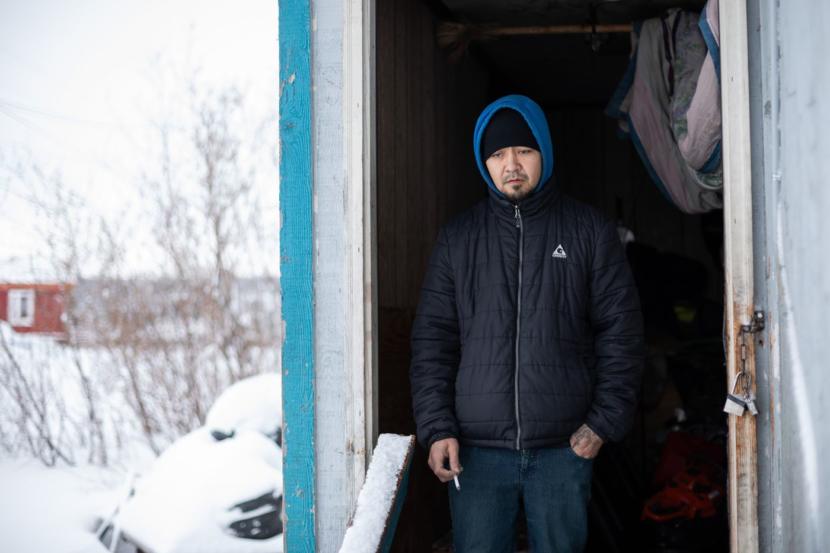
Sen. Lisa Murkowski, a Republican who has pursued federal funding for village tribal courts, recently called on U.S. Attorney General William Barr to visit Alaska villages to see the public safety problems firsthand.
But there’s a big difference between the court system and on-the-ground police, Murkowski said when informed by the Anchorage Daily News of how many Alaska communities have no police whatsoever.
“If we don’t have the law enforcement in the first place, it’s really hard,” Murkowski said. “People know that there’s not anybody there looking. It makes it easier to be the perpetrator.”
Research suggests that factors such as self determination, the presence of prominent traditional elders and employment opportunities — rather than more police — are the key to reducing suicide, alcohol abuse and other problems that have troubled many Alaska villages. But dozens of village and tribal leaders told the Anchorage Daily News and ProPublica they want and need police protection.
“When I’m here by myself and somebody comes pounding on my door and wants to beat the living daylights out of me, it would have been nice to have a VPSO in that next office,” said Mary Willis, tribal president for the Kuskokwim River village of Stony River.
In Wales, where a judge recently ordered the school district to pay $12.6 million after an employee sexually abused multiple girls, City Clerk Gerald Oxereok said the village hasn’t had any law enforcement for 20 years. On the shores of the Bering Strait, the whaling town is the westernmost city in mainland North America.
“Nobody has been applying for it,” Oxereok said of the vacant VPSO job. Some locals who might want the work don’t meet minimum requirements such as a high school diploma. Or they smoke pot or have a felony record, both of which are disqualifying.
When a screaming man broke the door to the tribal office in Kokhanok, a village on the shores of Iliamna Lake with 168 people and no police, tribe employee Lysa Lacson said she was forced to evacuate the building.
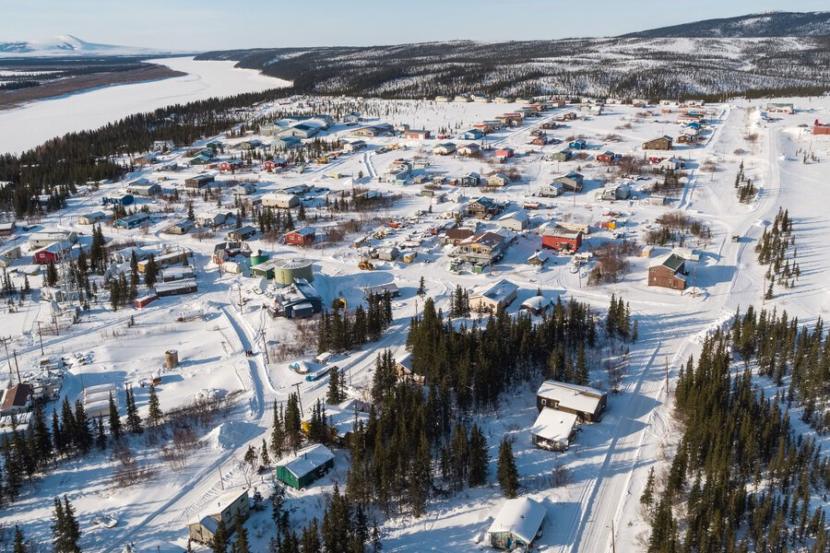
Troopers arrived three days later.
That was in December, Lacson said. The tribe told local airlines that the man was forbidden from flying back to Kokhanok. But that doesn’t always work. Sometimes the banished fly in to a different village and boat home, she said.
“We’re not trained in responding to those things,” Lacson said.
On the same day that Annie Reed investigated the home invasion rape case, a man attacked three people with a butcher knife in the Yup’ik fishing village of Kotlik some 280 miles to the south. Troopers say the suspect appeared at a schoolhouse vowing to kill the principal, who in turn warned villagers of the attack over VHF radios. The custodian locked the school doors and teachers herded students into the gymnasium and lunchroom, where adults stood guard at entrances.
Kotlik tribal administrator Pauline Okitkun said the town sometimes has village police officers, depending on funding. There was a young woman employed as one at the time, she said, but the call was too dangerous for her to handle unarmed and alone.
The man stabbed three people, including one who struck his arm with a piece of rebar to try and knock free the 8-inch knife, according to charges filed against him. The suspect also stabbed his sister in the stomach, but she was able to snatch the weapon away, according to the charges. Villagers held him in a cell until troopers arrived by plane more than two hours after the attack and school lockdown began. A Bethel judge ordered a competency evaluation for the suspect, who is awaiting trial and, according to the court clerk, has not entered a plea.
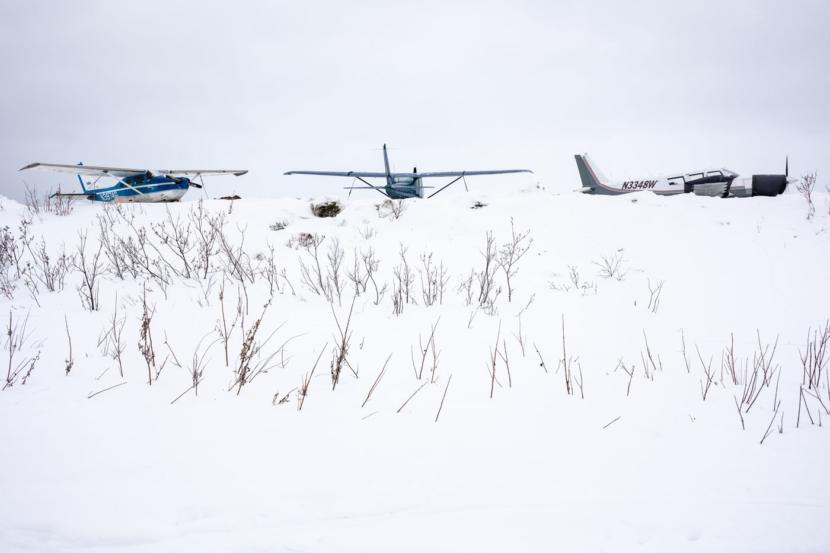
Kotlik, near the mouth of the Yukon River, is in Western Alaska, an area with the highest rate of reported sex crimes in the state. Leaders from 56 tribes in the region have listed public safety as their top concern in each of the past two years, according to the regional nonprofit, the Association of Village Council Presidents.
The council visited 45 communities in Western Alaska in 2018 to photograph dilapidated public safety buildings and count police officers. The resulting report found that eight villages had no jail cells of any kind. In others, if there were local police, the officers worked in headquarters with boarded doors, broken windows or no indoor plumbing. In one of those buildings, two inmates burned to death on April 28 while locked in their cells. The council researchers had flagged problems with the window, door lock and stairs months earlier.
“The idea that there are places in the United States, a first-world country, that do not have public safety … a basic human right, was horrifying to me,” said Azara Mohammadi, a council employee who worked on the survey.
In one of the larger surveyed communities, Mountain Village, population 804, the nonprofit found only one village police officer remains after another officer had been charged with stealing from the scene of a homicide. The Yukon River village’s public safety problems continued on a Friday afternoon in March, when the Mountain Village officer arrested a man accused of raping two people and took him to a jail cell housed within the steepled city office.
When an Alaska state trooper arrived the next afternoon, he discovered the jail empty and no guard on duty. The 19-year-old suspect had escaped overnight. By the time the trooper found and arrested him, he’d been missing for 16 hours. He has pleaded not guilty on charges of sexual assault, giving alcohol to a minor and felony escape.
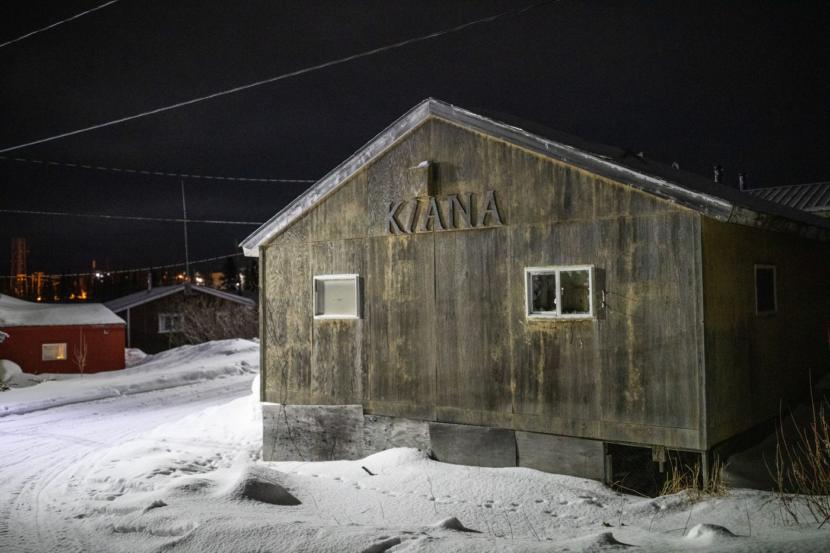
Two Classes of Alaskans
Oil taxes, and savings accounts that were built upon oil taxes, pay the bills in Alaska. But even in times of plenty, when 2 million barrels were flowing through the trans-Alaska oil pipeline every day or when North Slope crude prices skyrocketed, the state has struggled to provide core services to villages.
Today, thousands of rural homes in 29 villages still lack running water and flush toilets, according to the state Village Safe Water Program. The road system reaches only about one out of every five communities.
Unapologetic in directing billions in federal spending to Alaska, the late Sen. Ted Stevens argued the young state’s isolation and the unique needs of Alaska villages demanded heavy government investment. At the height of his funding powers as chair of the Senate Appropriations Committee, Stevens backfilled the VPSO program with $1.5 million in federal funding when the state cut spending on those officers in 2003.
Dunleavy, who was elected governor last year and subsequently declared a “war on criminals,” has proposed a spending plan that includes defunding vacant village police officer jobs while funding trooper recruitment. But troopers don’t just serve villages, they respond to crimes in highly populated areas on the road system — including much of the fast-growing Matanuska-Susitna Borough that Dunleavy and former Alaska Gov. Sarah Palin call home.
Dunleavy said the cuts to the VPSO program reflect the decreasing number of village officers. (Saying the program is now “plagued with high turnover and poor retention,” the Alaska Legislature this month announced the creation of a working group that will attempt to rebuild it.)
“The drop in VPSOs employed occurred despite pay increases, retention bonuses and approved funding for equipment and office improvements,” Dunleavy spokesman Matt Shuckerow said. “As a result, Gov. Dunleavy’s budget proposal aligns funding and historic expenditures within the VPSO program.”
Shuckerow said that starting pay for VPSOs has increased from $16.55 an hour in 2008 to $26.79 today. That amounts to about $56,000 a year, wages that VPSOs say is still woefully low given they receive nearly identical training to Kotzebue-based troopers who make three times as much.
Sen. Lyman Hoffman, D-Bethel, warned that the spending plan creates two classes of Alaskans when it comes to public safety protection.
“If you were living in that community for a year and we had someone going out and shooting up the place and you did not have an officer to go to talk to, I think you would feel as unsafe as they do,” Hoffman told the state budget director in January.
As rural Alaskans learned of the proposed cuts, Kiana city manager Ely Cyrus received an email from the head of the VPSO program in his region.
“Ely, just an FYI at this point in time we will not be hiring a new VPSO for Kiana,” it read, referring to the state-funded police officer job that offers higher pay and requires more training than Annie Reed’s role as a city cop. “The state is withdrawing funding for three positions in order to help provide the money to give the Alaska state troopers a 7.5 percent raise.”
Cyrus, who sometimes moonlights as a snowplow operator, gave a tour of the village public safety building with its two jail cells and a stack of paperbacks for the guards. Next door sat a mud-flecked home, housing for the VPSO, for the sporadic times there is one. Plywood covered the shattered living room windows.
“I’m Overwhelmed”
When a home invasion rape occurs in Alaska’s largest city, the Anchorage Police Department sends patrol cars with sirens blaring, Deputy Chief Ken McCoy said. One uniformed officer makes sure the victim is safe while others search for the suspect. Paramedics appear. A detective from one of two special sex crime units joins a victim’s advocate and a nurse to begin the investigation and rape kit exam. Back at the crime scene, an officer stands guard to preserve evidence.
Two plane rides and several hours away, above the Arctic Circle, all the village of Kiana had on the night of the home invasion rape was Annie Reed.
When she arrived at the scene, she said, it was too late to find an overnight safe house for the victim. The suspect, 42-year-old Edmond Morris, had a history of rape, pleading guilty to sexual assault in 2016. While in Kotzebue in 2017, he broke into the home of a legally blind woman who lives alone, according to charges filed against him. The woman hid in the bathroom to call police. Morris had spent the past 15 years in and out of jail before returning to Kiana.
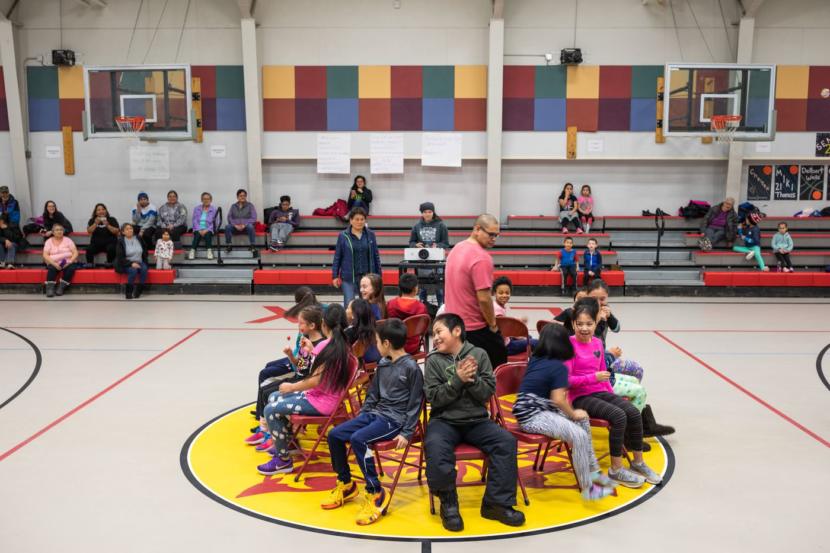
“Holy crap,” Trooper Anne Sears said she thought. Sears looked up Morris’ criminal record after learning of the alleged attack from Reed and investigated the case. “Everything he’s done. He’s done it before. Even his other cases were leading up to something similar.”
Reed said that when she asked the man to leave, he lingered around the home. With nowhere else to go and the midnight sun about to set, Reed took the woman to spend the night in her own home. (“Annie is freaking awesome,” said Sears, a longtime state trooper. “Kiana is lucky to have her.”)
One of Reed’s daughters fixed the woman a cot to sleep on in the living room, beneath the baleen and dreamcatchers. Another daughter traveled with the victim the next day to Kotzebue, but because there was no nurse available that day to begin a sexual assault exam, the victim flew another 550 miles to speak with city detectives in Anchorage. Her neck and wrists bruised, the young woman carried the gym shorts and ripped tank top she was wearing during the attack as evidence in a plastic bag.
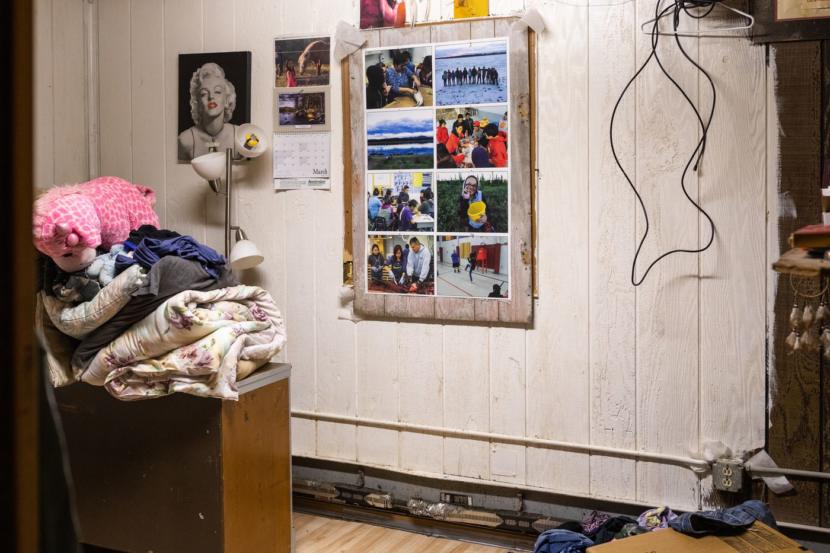
It took three weeks for troopers to complete an investigation and arrive in Kiana to arrest Morris. During that time, he returned to the home where the attack occurred several times to ask if the family planned to press charges, prosecutors allege. He faces charges of sexual assault, assault and criminal trespassing.
In a phone interview from the Nome jail, Morris said he did not attack the victim and said she let him in the window. When the victim’s mother told him to get out of the house, he did, he said.
Morris is awaiting trial with a hearing scheduled for July. The window that Morris is accused of breaking open in order to commit the sexual assault is now covered with plywood, adorned with smiling hunting photos torn from a calendar. Dents still tattoo the front door, but that happened later.
The young woman, after returning to Kiana, took an ax to the doorknob. She’d been drinking and tried to break down the door after an argument with her mom. When that didn’t work, she climbed through the same window that, according to troopers, her rapist had pried open. She was later found sitting in the living room, sobbing.
Her mother doesn’t know exactly where she is now. Probably Anchorage. They talk on the phone sometimes, but never about that night, the mother said. “She just keep it inside her.”
Reed, in the meantime, has a decision to make. A troopers sergeant in Kotzebue said she is among the most reliable of the village police officers in the region. But after fielding hundreds of calls in a recent month, and deaths in the family, she has started looking for a job with days off. Or at least benefits.
“I’m tired,” she said.
A long sigh.
“I’m overwhelmed.”
As the anniversary of the home invasion rape approached, something unexpected happened. The VPSO who said he was attacked during a domestic violence call in the village of Ambler, 70 miles upriver, was reassigned by the borough. On April 30, he showed up in Kiana, the city manager said. Backup for Annie Reed.
But the move had a downside: It made Ambler, population 287, the 70th village in Alaska to have no police of any kind at some point this year.
ProPublica and the Anchorage Daily News are spending the year investigating sexual violence in urban and rural Alaska. Here’s how you can stay in touch with us:
- Get email updates.
- Share your story in our questionnaire.
- Reach out to the reporting team anytime: alaska@propublica.org
